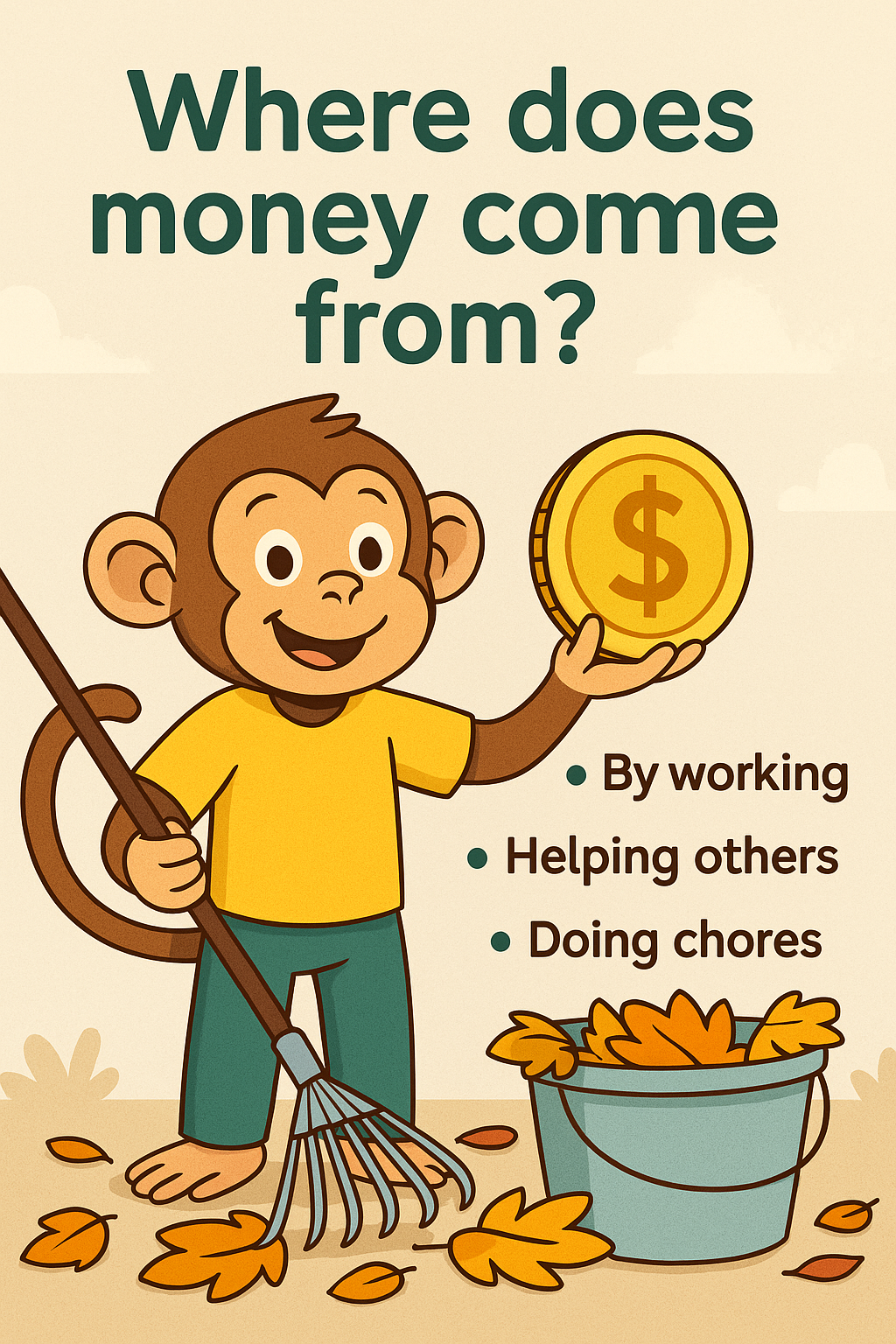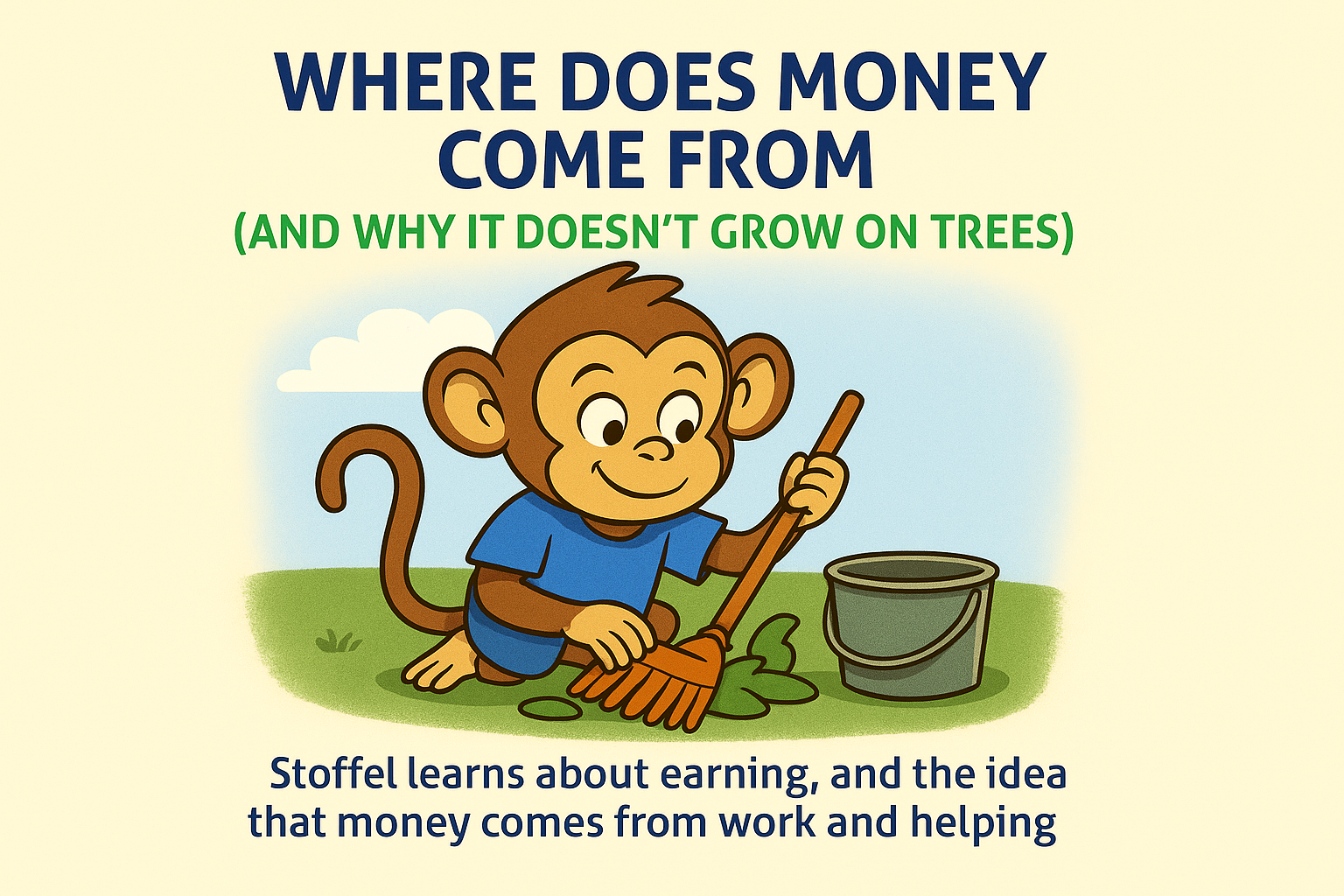💸 Where Does Money Come From? (And Why It Doesn’t Grow on Trees)
👨👩👦 A Note to Parents
By now, your child understands how to save and spend, spot needs versus wants, and even make a mini budget. Now it’s time to talk about where money actually comes from – and why it doesn’t magically appear.
This post introduces the concept of earning: the idea that money is a result of effort, value, and contribution. It sets the foundation for future lessons around jobs, entrepreneurship, and making smart choices about how to earn and use money.
🐵 A Story for Kids: Stoffel’s Money Tree Dream
Stoffel the Monkey was lying in the grass, staring at the clouds, when he had a brilliant idea.
“I need more banana coins,” he said. “Maybe I can just plant one and grow a money tree!”
So he took one shiny coin, dug a hole, and carefully dropped it in.
Every morning, Stoffel checked the spot.
Day 1: Nothing.
Day 2: Still nothing.
Day 3: “Maybe it needs water…”
Day 4: “Maybe I should sing to it?”
Day 5: “Maybe… money doesn’t grow on trees?”
He stomped off to ask Grandpa.
Grandpa Monkey laughed gently. “Stoffel, money doesn’t grow from the ground. It comes from doing something helpful – like work.”
“Work?” Stoffel asked.
“Yep. I earn banana coins by fixing nests and painting treehouses. When I help others, they give me coins to say thank you. That’s how I earn my money.”
“Ohhh…” Stoffel said. “So if I want coins, I need to do something useful?”
Grandpa smiled. “Exactly.”
The next day, Stoffel offered to help his neighbor pick coconuts. He got two coins. Then he helped Lila the Parrot clean her feathers – and earned another one.
By the end of the week, his coin jar was full again. No money tree needed.
🧠 The Big Idea
Money isn’t just something you get – it’s something you earn. People earn money by working, helping, and contributing in ways that others find valuable.
The more helpful or skilled the work, the more money someone can often earn. It’s not about getting lucky. It’s about showing up, trying hard, and solving problems.
💬 How to Talk to Your Child
- “What jobs do you think I do to earn money?”
- “Can you think of any ways you help at home or school?”
- “What are some small jobs you’d like to try in exchange for coins?”
- “Why do you think people get paid for doing work?”

🏡 Try This at Home
Start a Mini Job Board
Create a list of optional tasks your child can choose from – beyond basic responsibilities – with a reward (e.g. 50 cents for watering plants, $1 for sorting laundry).
Let them connect the dots: effort → contribution → earnings.
Help Them “Earn to Save”
If they have a savings goal (like a toy or book), help them calculate how many mini jobs they’d need to do to reach it. This reinforces the connection between working and saving.
Share Your Own Work Stories
Talk about your job and why you get paid for it. Share challenges you face and why your work matters – it helps children understand the value of contribution beyond just the money.
🧭 Final Thought
Helping your child understand that money is earned – not just received – builds a mindset of contribution, self-reliance, and gratitude. It teaches that effort has value and sets the stage for responsible earning, spending, and saving habits in the future.
Next up, we’ll explore bigger concepts like value, entrepreneurship, and different ways people earn money in the world. For now, it’s enough to understand this:
💡 You don’t need a money tree – just a willingness to help, learn, and do good work.
This is the fourth and final article in the StoffelWealth miniseries “Money Foundations for Kids”. Click on the following links to read the other parts:
Part 1: Save or Spend? Helping Kids Make Smart Money Choices
Part 2: Needs vs Wants: Helping Kids Make Smart Money Choices
Part 3: What Is a Budget? (For Kids!)

